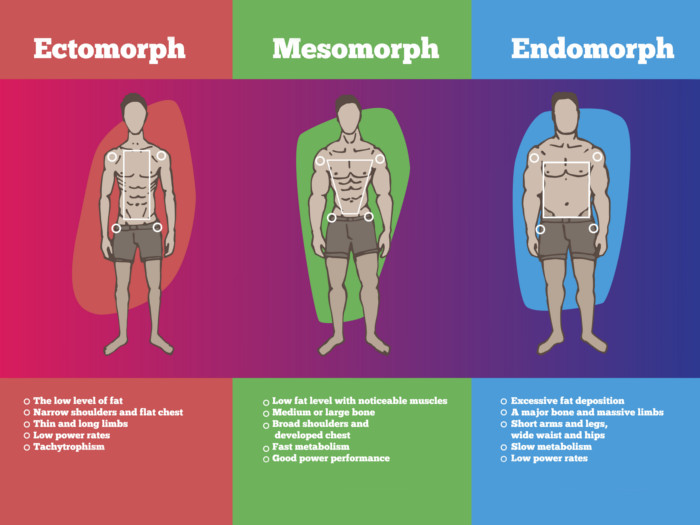The endomorph body type is relatively solid, bulky, and soft. This body type is popular for gaining fat very easily. Endomorphs are normally of a stout build with thick arms and legs. Their muscles are strong, especially the upper calves. Endomorphs find they are naturally strong in leg exercises like the squat.
The endomorph diet is a helpful diet and exercise plan if you fall within an endomorph body type and struggle to control your weight.
What is an Endomorph Diet?
An endomorph diet is one that is designed for people who are bigger-boned and tend to put on weight more easily. Everybody is different, but generally speaking, they fall into three different categories – ectomorphs, mesomorphs, and endomorphs. Ectomorphs are generally tall and thin and have a harder time putting on weight, while mesomorphs tend to be more muscular and athletic, and can easily control their weight. Endomorphs are the final category, and tend to have a larger body type that can gain weight quickly; you may also struggle with your fat levels. While this body type is present in both women and men, women often struggle more with losing their weight. [1] [2]

Illustration of three different body types Photo Credit: Shutterstock
While mesomorphs are able to build muscle easily, endomorphs tend to react very quickly to the overconsumption of food, often storing those excess calories as fat. For this reason, a specific dietary plan and exercise regimen should be followed if you are an endomorph who wants to take control of your health.
Endomorph Diet Plan
If you intend to follow an endomorph diet, you will need to follow strict guidelines on the types of foods you eat, along with a certain lifestyle and mealtime changes. This diet is not about drastic calorie reduction but is a long-term diet plan to gradually shed weight in a healthy way. According to the American Council of Exercise, if you are an endomorph, you should aim for a diet that comprises 30 percent carbohydrates, 35 percent protein, and 35 percent fat. The fat content should be in the form of healthy fats such as avocado, ghee (clarified butter), grass-fed butter, or olive oil. You should only reduce your caloric intake by roughly 340-500 calories from your normal diet. [3] [4]
Foods to Include
- Lean protein (white chicken, turkey, and beef)
- Healthy fats (olive oil)
- Carbohydrates (broccoli, asparagus, greens, fruits, beans, and legumes)
- Nuts
- Fatty fish
- Walnuts
- Cheese (low to non-fat)
- Seeds
Tips for an Endomorph Diet
Each meal should have a mix of protein, vegetables, and healthy fats.
- Fill up on veggies: The nutrient density and high level of fiber will help you feel full and prevent overeating. [5]
- Eat slowly and mindfully: Enjoy your food and the people around you. Pay attention to the texture, flavor and truly savor the moment. The slower you eat, the more time your body will have to let you know when it’s full.
- Stop eating when you’re 80% full: In Okinawa an established ‘blue zone’ where one of the longest-lived populations are there’s a term for this called ‘Hara Hachi Bu’ which they say before every meal. It means to stop eating when you are 80% full because it takes up to 20 minutes for ‘fullness’ to register in our stomach.
- Prioritize protein: Protein is the macronutrient that makes you feel full the quickest! Also, protein has the largest loss to the ‘thermic effect of food’ of all of the macronutrients; 25% of the calories in protein are lost when converted to energy. Eating protein will help you build muscle, rather than store fat.
Sample Meal Plan
- Breakfast: 2 scrambled eggs, 1/2 avocado, 1 piece of chicken sausage, wilted spinach.
- Lunch: 4 ounces of baked chicken in addition to a salad with a variety of greens and other non-starchy vegetables of choice, and a healthy dressing without added sugar (try to make your own dressing blend at home using olive or balsamic vinegar as the main ingredient)
- Dinner: Homemade chili, 1 cup of steamed broccoli, a hand full of low salted nuts, or low-fat cheese, and natural peanut butter with an apple or a few whole-wheat crackers
Endomorph Diet Exercises
The endomorph diet is not only about eating the right foods, but also about exercising in the right way. If you want to lose weight, you will need to combine cardiovascular exercises with strength training 4-5 times each week. The goal is to burn an additional 250 calories, on top of the 250 calories you shaved off your daily intake of food. Perform at least 30 minutes of physical activity each day. [6]
Ideas on Building Strength Training and Cardiovascular Exercise
Consider joining a group training class
- Pick a class that combines both strength training and high intensity work all into one hour a day. This has the added benefit of giving you access to a coach that can help you assure your movements are correct and will not result in injury
- Orange theory
- Bootcamp classes
- HIIT classes (high-intensity interval training)
- Camp gladiator
Build natural movement into your day
- Bike to work
- Take the stairs rather than the elevator
- Walk to the grocery store, to your friends’ house, or to your local park
- Do your own yard work with a push lawnmower
- Join a gym close enough to your work or home that you can walk to and from
Get a Health Coach
- If you’re having trouble staying accountable get a credible health coach that can help you learn how to track your calories, macros, and workouts
